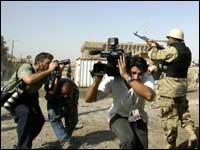Transcript
Novelist and journalist Jim Lewis used to believe that in wartime graphic photographs were crucial to documenting atrocities. He himself had taken such photos in Congo. Then, in 2004, he changed his mind. The story of Falluja had broken. Four American contractors had been murdered and their bodies hanged from a bridge for all the world to see. Those images prompted Lewis to write a piece for Slate, arguing that graphic documentation of violence doesn’t necessarily help anyone understand the story.
I spoke with Lewis four years ago but his ideas resonate with our program today.
JIM LEWIS:
Part of the problem with printing photographs like this is that they tend to strip away any of the context which would help anybody actually understand the story. You know, [LAUGHS] what did these guys look like before this happened? You know, what were they traveling in? What part of town were they in? How many people actually were there?
All of that gets lost in the grisly sight of these bodies hanging from a bridge. I just think that, to the extent that it's the function of journalism to explain things to people, photographs like this actually do less explaining than one might otherwise wish.
BOB GARFIELD:
Your thinking on the subject changed, based on your own work in Eastern Congo.
JIM LEWIS:
Mm-hmm. [AFFIRMATIVE]
BOB GARFIELD:
You were there almost a year ago. Tell me about your experience.
JIM LEWIS:
Yeah, it was based in a little town called Bunia. And we went out of town one day, myself and another reporter and a photographer, up into the hills outside of town where we had heard that there had been a massacre, and we got there, and there was, and - there was nobody else there except for the people who had died. And they had been not just killed but dismembered, and in a particularly horrific way.
And after I had finished sort of taking my notes, and the people I was with had other work to do, and I didn't know what to do, and I was just kind of standing around, and took out my camera and took a lot of photographs.
BOB GARFIELD:
So what you had in your camera was something shocking, something extraordinary. At what point did you know that your mind had changed and that whatever these pictures were, they were not something to be shared with a mass audience?
JIM LEWIS:
I would be talking to friends and family and people that I worked with and trying to explain what was going on in the Congo and what I had seen, and I would show them these photographs along with others. And I just found that they got in the way of trying to tell the story I wanted to tell, and that, in fact, rather than clarifying the story, the shock of the photographs had a tendency to derail both my telling of the story and other people's understanding of it.
BOB GARFIELD:
In your piece in Slate, you referred to a story where a man killed himself, and that the suicide was captured by the security cameras in his building and then somehow found their way to an Internet site that traded in shocking video footage and so forth. And the mother of the victim, I believe, was beside herself wondering how her son's death could turn into a sort of pornography.
JIM LEWIS:
What I mean by pornography is just that the fact that such a thing exists on film at all is often so surprising to people or so shocking or exciting, or whatever it may be, that it tends to overwhelm the information that the pictures would otherwise actually convey.
BOB GARFIELD:
Now, I saw the Falluja pictures when they were first published and aired and they were genuinely horrifying. But I must say I was not as moved by them as I was by a single line in a single wire story about one of the kidnappings in Iraq. It was of a Jerusalem resident who evidently also has a United States' driver's license, and the kidnappers, to prove that they had this guy in custody, were showing his passport and his U.S. driver's license and, and, um, his supermarket frequent shopper's card. And the very quotidian nature of a supermarket frequent shopper's card was so humanizing for me that I, I, I got very choked up, far more than I did from the most graphic pictures emerging from the war.
JIM LEWIS:
I have much the same sort of reactions. I used to think that only a photograph can really accurately convey what goes on in a war, and that anything less than absolute explicitness would amount to a kind of whitewashing, and I think, in fact, that's simply not true. A well-written paragraph can be just as informative and just as horrifying and, and just as touching but doesn't run the same kinds of risks.
BOB GARFIELD:
Well, Jim, thank you very much.
JIM LEWIS:
Thank you.
BOB GARFIELD:
Jim Lewis is a novelist. I spoke with him in 2004.
